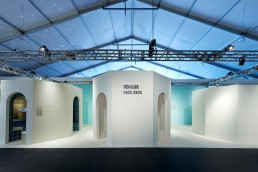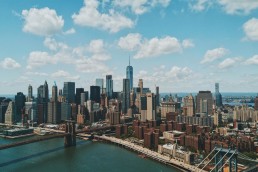Video agency Cube has released its first original documentary, titled Sustainability: A Broken Record. Delving into the true meaning of sustainability with the thoughts architects, designers and manufacturers, the documentary explores how the industry can manage the relationship between people and planet, unearthing the secrets to a more substantial impact, and discovering how powerful decisions can move the sector forward towards a nourishing future.
“Cube has become well embedded within the design and architecture community, and sustainability is a buzzword which we hear all too often,” says co-founder and CEO James Hakesley. “But it’s one that comes with so many caveats. Our first in a series of original productions captures an honest and powerful conversation to engage audiences, provoke conversation and inspire critical change.”
Playing on the title’s reference to a record, the production is organised into two halves. The A-side highlights the challenges the industry is facing, while the B-side focuses on solutions, relationships, and asks tough questions like ‘what does it mean to be sustainable?’ and ‘is sustainability really enough?’.
Owen Riseley, Lead Producer at Cube and Director and Editor of the documentary, comments: “Sustainability is built around fear and facts, but clearly, the truth isn’t enough. We set out to create a film that inspires, and that is centred around understanding our relationship with this subject, rather than trying to scaremonger. By approaching the documentary in this way, we buck the trend of how content today is addressing sustainability, and broaden our reach as to who we inspire.”
The film takes the audience on a journey into the lives of its subjects, prompting viewers to consider more substantial attitudes, behaviours and consumer habits. One of the industry leaders involved, Jeremy Grove – Managing Director and Head of Design at Sibley Grove – sets the tone by explaining that “there’s still a general lack of understanding of what it means to be better environmentally”. He adds: “Sustainability is incredibly misleading and there’s a lot of people who want to do good things but they’re being misled by products that aren’t actually solving the problem.”
Nico Rensch, Architect and founder of Wunderhaus, also welcomes viewers into Wunderhaus; a house that can produce net more energy than it consumes, and the only net energy positive capable housing product in the UK. He reveals: “We tried to create something that has all the virtues of a product, but in the form of a house. We’re living in the 21st century and our houses perform so poorly in a time when we have an acute climate crisis and a massive energy crisis. It’s just not acceptable.”
Echoing that thought, Rachel Hoolahan, Architect and Sustainability Coordinator at Orms, argued that people must adapt and challenges the audience to think about how they as individuals can make an impact in this world. “As an industry, we’re facing an enormous challenge in figuring out how we can design high quality spaces for our society, without sacrificing the land and lives of others. Sometimes, it feels like we are playing a broken record, but equally, we can see this repetition as a positive starting point. As the documentary demonstrates, we as an industry need to be a collective voice, calling for greater change and collaborating to make sure it happens. The real question is, do we have enough time to do it?”
Studio Suss founder Simone Suss also features in the film, showing viewers around one of her practice’s recent projects; a 13,000ft² house in Greater London, highlighting how sustainability has been incorporated “in an invisible way”. Suss explains that she has always been conscious about trying to do good, and questions, “if not me, then who? And if not now, then when?”
Finally, John Miller, Furniture Designer and Director at Mark Product, invites the industry into his workshop, explaining how he grew up surrounded by his father’s tools. Miller explores the evolution of design, the importance of relationships and the transformation that the A&D community must go through, concluding: “It needs to be articulated as a new adventure.”
The full documentary can now be viewed on here.
Related Posts
6 December 2022
The Langham, Diriyah to open in 2026
6 December 2022
Experience Transcendence with Kohler at Design Miami/ 2022
6 December 2022



